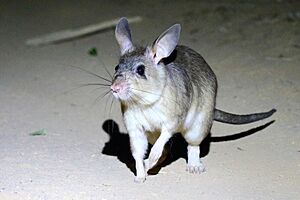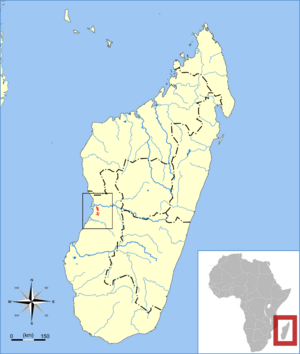Malagasy giant rat facts for kids
Quick facts for kids Malagasy giant ratTemporal range: Holocene
|
|
|---|---|
 |
|
| Wild Malagasy giant rat at the Kirindy Forest Reserve, Madagascar | |
| Conservation status | |
| Scientific classification | |
 |
|
| Malagasy giant rat range |
The Malagasy giant rat (also called the votsotsa) is a special type of rodent found only on the island of Madagascar. These amazing animals live in a small area called the Menabe region. They are an endangered species, which means there are not many left in the wild. This is because their home is shrinking, they don't have many babies, and they only live in a small space.
Malagasy giant rats are very loyal. A male and female rat will stay together for their whole lives. They usually have only one or two babies each year. This rat is the only living species in its group, Hypogeomys. Another species, Hypogeomys australis, lived thousands of years ago.
Contents
What Does the Malagasy Giant Rat Look Like?
Malagasy giant rats look a bit like rabbits, but they still have many features of a rat, especially their face. Both males and females can grow to be about the size of a rabbit. They weigh around 1.2 kilograms (2.6 pounds) and are about 33 centimeters (13 inches) long. They also have a long, dark tail that adds another 20 to 25 centimeters (8 to 10 inches) to their length.
Their fur is rough and can be gray, brown, or reddish. It's usually darker around their head and lighter, almost white, on their belly. They have big, pointy ears and strong back legs. These powerful legs help them jump high to escape from danger. They can leap almost 90 centimeters (3 feet) into the air! Because of this, some people call them giant jumping rats.
Reproduction and Family Life
Once a male and female Malagasy giant rat find each other, they stay together forever. If one of them dies, the female often stays in her burrow until a new male arrives. Males usually wait for a new partner too, but sometimes they will move to live with a female who has lost her mate.
Females usually give birth to one baby at a time. This happens once or twice during the mating season, which is from December to April. The babies are born after about 102 to 138 days. Both parents help raise the young. The babies stay safe in the family burrow for the first 4 to 6 weeks. After that, they start to explore and look for food outside.
Young male rats stay with their family for about one year before they leave to find their own home. Female rats take longer to grow up; they stay with their parents for two years. Male parents are very protective of their babies. They will even put themselves in danger to follow or protect their young ones.
Lifestyle and Daily Habits
Malagasy giant rats are nocturnal, which means they are active at night. They live in burrows underground that can be up to 5 meters (16 feet) wide. These burrows can have as many as six entrances. Even the entrances they use regularly are kept blocked with dirt and leaves. This helps keep out predators like the Malagasy ground boa.
In the past, their main natural enemy was the fossa, which looks a bit like a small puma. But now, stray dogs and cats that have been brought to the island also hunt them. When the rats look for food, they walk on all fours. They search the forest floor for fallen fruit, nuts, seeds, and leaves. They also sometimes eat tree bark or dig for roots and insects.
Each pair of rats has its own special area, called a territory. Both the male and female will protect their territory from other rats. They mark their area using their urine, feces, and special smells from their scent glands.
Protecting the Malagasy Giant Rat
The Malagasy giant rat is listed as critically endangered. This means it is very close to disappearing forever. There are several reasons for this. They live in a very small area, and their home is being destroyed. More and more stray dogs and cats are hunting them. Also, diseases like hantavirus and toxoplasmosis are making the rats sick. Toxoplasmosis can make rodents lose their fear of cats, which makes them easier to catch. Hantavirus can cause kidney problems.
The government of Madagascar has made laws to protect these giant rats. A large part of their home is now the Kirindy Forest Reserve. In this reserve, people practice sustainable forestry, which means they cut down trees in a way that doesn't harm the forest too much. The government also has plans to help people and animals live together peacefully.
A scientist named Gerald Durrell was the first person to successfully breed these rats in captivity. In 1990, he brought five rats to Jersey. Since then, 16 breeding programs have been started, and 12 of them have been successful. These efforts help to ensure that these unique animals can survive for future generations.


